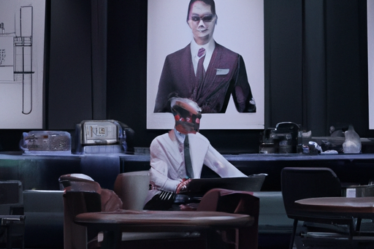
The Evolution of Visual Storytelling in Iconic Music Videos
Music videos have become an integral part of the music industry, providing artists with a platform to showcase their creativity and connect with their audience on a visual level. Over the years, music videos have evolved from simple performance-based visuals to complex narratives that tell a story. In this article, we will explore the inspirations behind iconic music videos and how visual storytelling has evolved in the industry.
One of the earliest examples of visual storytelling in music videos can be traced back to Michael Jackson’s groundbreaking video for “Thriller” in 1983. Directed by John Landis, the video drew inspiration from classic horror films, featuring a narrative that unfolded like a mini-movie. This innovative approach to music videos set a new standard for the industry and paved the way for future artists to experiment with storytelling in their visuals.
As the years went by, music videos continued to push boundaries and explore new creative territories. Madonna, known for her provocative and boundary-pushing visuals, released the iconic video for “Like a Prayer” in 1989. Directed by Mary Lambert, the video tackled controversial themes such as racism and religion, sparking a nationwide debate. The video’s narrative, combined with Madonna’s powerful performance, created a lasting impact and solidified her status as a visual pioneer in the music industry.
In the 1990s, music videos took a more cinematic approach, drawing inspiration from movies and incorporating elaborate sets and costumes. Take, for example, the video for Nirvana’s “Smells Like Teen Spirit,” directed by Samuel Bayer. The video captured the essence of teenage rebellion and angst, with its gritty visuals and energetic performances. This video, along with others from the grunge era, showcased a raw and authentic side of music videos that resonated with audiences.
As technology advanced, so did the possibilities for visual storytelling in music videos. With the rise of CGI and special effects, artists were able to create fantastical worlds and bring their wildest imaginations to life. One notable example is Beyoncé’s video for “Single Ladies (Put a Ring on It)” in 2008. Directed by Jake Nava, the video featured a simple yet mesmerizing choreography that became a viral sensation. The video’s minimalist aesthetic, combined with Beyoncé’s captivating performance, made it an instant classic.
In recent years, music videos have embraced a more experimental and abstract approach to storytelling. Artists like Kendrick Lamar and Childish Gambino have released videos that challenge societal norms and tackle important social issues. Lamar’s video for “HUMBLE.,” directed by Dave Meyers, explores themes of beauty standards and self-acceptance, while Gambino’s video for “This Is America,” directed by Hiro Murai, addresses gun violence and racial inequality. These videos not only entertain but also provoke thought and spark conversations, showcasing the power of visual storytelling in music.
In conclusion, the evolution of visual storytelling in iconic music videos has been a fascinating journey. From the early days of simple performance-based visuals to the complex narratives we see today, music videos have become a powerful medium for artists to express their creativity and connect with their audience. Whether drawing inspiration from classic films, pushing boundaries with controversial themes, or utilizing cutting-edge technology, music videos continue to captivate and inspire viewers around the world.
Unveiling the Creative Process: Behind-the-Scenes of Iconic Music Videos

Music videos have become an integral part of the music industry, often serving as a visual representation of the artist’s creative vision. These videos not only enhance the listening experience but also provide a platform for artists to showcase their talent and express their artistic ideas. Behind every iconic music video lies a creative process that involves a multitude of inspirations and careful planning.
One of the key inspirations behind iconic music videos is the song itself. The lyrics, melody, and overall mood of the song often serve as a starting point for the visual representation. Artists and directors work closely together to ensure that the video complements the music and effectively conveys the intended message. For example, a melancholic song may inspire a video with a somber and introspective atmosphere, while an upbeat track may call for a vibrant and energetic visual representation.
Another significant source of inspiration for music videos is the artist’s personal experiences and emotions. Many artists draw from their own lives and use their videos as a means of self-expression. By incorporating personal elements into their videos, artists can create a deeper connection with their audience. This authenticity allows viewers to relate to the artist on a more personal level, making the video more impactful and memorable.
In addition to personal experiences, music videos often take inspiration from various forms of art. Directors and artists may draw from films, paintings, literature, or even fashion to create a visually stunning and thought-provoking video. By incorporating elements from different art forms, music videos can transcend the boundaries of traditional storytelling and create a unique and captivating visual experience. This fusion of art forms not only adds depth to the video but also allows for a broader interpretation by the audience.
Furthermore, technology plays a crucial role in shaping the creative process behind music videos. Advancements in technology have opened up new possibilities for artists and directors to experiment with visual effects, animation, and virtual reality. These technological advancements have revolutionized the way music videos are created, allowing for more imaginative and visually striking productions. From elaborate sets to intricate CGI, technology has become an essential tool in bringing the artist’s vision to life.
The creative process behind iconic music videos also involves collaboration between artists, directors, and production teams. This collaborative effort ensures that the video aligns with the artist’s vision while also incorporating the expertise and creative input of the team. By working together, artists and directors can push the boundaries of creativity and create videos that leave a lasting impact on the audience.
In conclusion, the creative process behind iconic music videos is a complex and multifaceted journey. From drawing inspiration from the song itself to incorporating personal experiences and various art forms, artists and directors work tirelessly to create visually stunning and emotionally resonant videos. With the help of technology and collaboration, these videos transcend the boundaries of traditional storytelling and provide a platform for artists to express their creativity and connect with their audience on a deeper level. So, the next time you watch an iconic music video, take a moment to appreciate the thought, inspiration, and hard work that went into bringing it to life.
Impact and Influence: Exploring the Cultural Significance of Iconic Music Videos
Music videos have become an integral part of the music industry, often serving as a visual representation of a song’s message or an artist’s creative vision. Over the years, there have been numerous iconic music videos that have left a lasting impact on popular culture. These videos not only entertained audiences but also influenced fashion, art, and even societal norms. In this article, we will explore the impact and influence of some of these iconic music videos, delving into the cultural significance they hold.
One such music video that has had a profound impact is Michael Jackson’s “Thriller.” Released in 1983, this 14-minute masterpiece revolutionized the music video genre. Directed by John Landis, “Thriller” combined elements of horror and dance, creating a visually stunning experience. The video’s narrative, featuring Jackson as a werewolf, captivated audiences and showcased his incredible dance skills. “Thriller” not only became a global sensation but also paved the way for longer, more cinematic music videos.
Another iconic music video that left a lasting impact is Madonna’s “Like a Prayer.” Released in 1989, this controversial video tackled themes of religion, racism, and sexuality. Directed by Mary Lambert, “Like a Prayer” sparked outrage among religious groups due to its provocative imagery and storyline. However, it also sparked important conversations about freedom of expression and artistic interpretation. Madonna’s boldness in addressing sensitive topics through her music video challenged societal norms and pushed boundaries.
Moving into the 1990s, we cannot overlook the impact of Nirvana’s “Smells Like Teen Spirit.” Directed by Samuel Bayer, this video perfectly captured the grunge movement of the time. With its raw energy and rebellious spirit, “Smells Like Teen Spirit” resonated with disenchanted youth around the world. The video’s low-budget aesthetic and chaotic high school setting became a symbol of the alternative music scene, influencing countless bands and artists in the years to come.
In the early 2000s, the music video landscape was forever changed by the release of Beyoncé’s “Single Ladies (Put a Ring on It).” Directed by Jake Nava, this video showcased Beyoncé’s incredible dance skills and empowered women everywhere. The iconic choreography, featuring Beyoncé and her backup dancers in black leotards, became a viral sensation and inspired countless parodies and dance covers. “Single Ladies” not only solidified Beyoncé’s status as a pop culture icon but also set a new standard for visually captivating and empowering music videos.
In recent years, music videos have continued to make a significant impact on popular culture. Childish Gambino’s “This Is America” is a prime example. Directed by Hiro Murai, this video tackles issues of gun violence and racial inequality in America. Its powerful imagery and symbolism sparked important conversations about the state of the nation and the role of art in addressing social issues. “This Is America” demonstrated the potential of music videos to serve as a platform for social commentary and activism.
In conclusion, iconic music videos have had a profound impact on popular culture, influencing fashion, art, and societal norms. From Michael Jackson’s groundbreaking “Thriller” to Beyoncé’s empowering “Single Ladies,” these videos have left a lasting impact on audiences worldwide. They have challenged societal norms, sparked important conversations, and pushed the boundaries of artistic expression. As music continues to evolve, we can expect music videos to remain a powerful medium for artists to convey their messages and inspire audiences for years to come.


